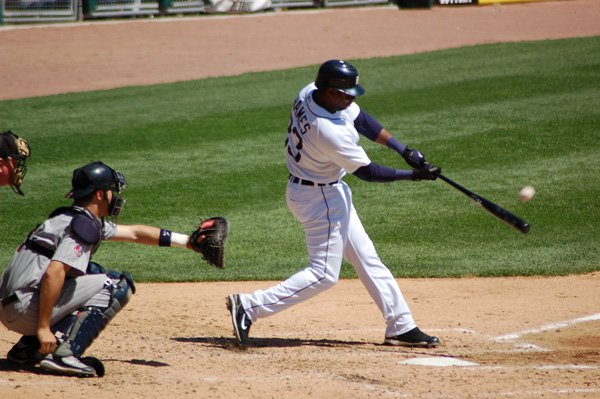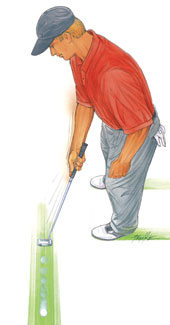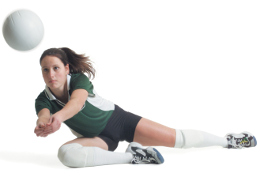Hitting up the ball
Question
Hows it goin',
Im 17 and play tighthead or sometimes loosehead for my rugby union school team. Im 6 foot 4 and weigh about 118kg.
I was just wondering about hitting up the ball, although i try my hardest and take some big knocks i don't seem to gain any ground maybe due to body positioning. If you had any info the could help me out it would be much appreciated.
Sean - Australia
Answer
Dear Sean,
I am not sure what you are asking. I will assume it is taking the ball into contact.
Going into contact carrying the ball well is usually more a matter of good technique than pure strength or power.
Almost all actions taken by a forward in rugby evolve from the same basic body position. It is very similar to the crouch position used by wrestler to perform squats:
-Outside edge of heels in line with your shoulders
-Toes pointed forwarded
-Knees bent
-Hips square
-揝pine in line?
-Back bowed inward
-Shoulders square and a little back
-Head up
There are many ways to go into contact. I will describe the two classic oldie, but goodie techniques that I use.
The first is the classic 損ower step?
First, let us assume that you are moving in with a body position similar to what is described above and holding the ball with two hands.
About five meters out, you make a decision ?go into contact, pass the ball, kick the ball, etc.
Once the decision has been made, carry on through (do not decide to go into contact, then try to pass the ball)
Once the decision has been made to go into contact, start to rotate your body so that your side is facing the opposition.
Prior to making contact:
-Establish a solid base (that squat position again)
-Plant your forward foot as forward as possible, best case is between your opponents feet
-lean back a little on your rear foot
-bend your knees (crouch)
-tense your body, especially your shoulder
-Protect the ball by keeping it in both hands and placing it on your opposite hip.
-Do not let your shoulder go beyond your forward knee (this will make you unstable)
Upon contact:
-When your shoulder and upper arm makes contact with you opponent, ensure that there is a straight line in your body from the tip of your shoulder to your rear heel on the ground (do not tilt your shoulder down, or lower your head.
-Take the contact, bending your rear knee a little to take the shock.
-Upon contact, your opponent should be knocked back (essentially he ran into a brick wall, you)
-At this point attack.
-As you become comfortable with this technique, you can modify it to work better for you.
Remember, rotate the body and be in good body position prior to contact!
The second is the 揵aseball bat?br>
With this technique prior to making contact,
-Rotate your body
-Plant your forward foot
-Lean back a little on your rear foot
-Bend your knees (crouch)
-Essentially establishing a solid 揵ase?
Next, you protect the ball by placing it in the valley formed between the upper thigh and waist when you crouch and putting your rear forearm and hand over the ball to secure it. This is where the 揵all?comes in.
Now that you have established the base and are protecting the ball, you are ready for contact. You extend your free arm forward with the hand up and fingers extended (do not ever make a fist). You attempt to make contact with your hand on to your opponent's inside chest or shoulder, thus knocking him off balance. The old English term for hitting someone is to 揵at?him. This is how this technique came to known as the 搕he Baseball bat? It is generally a static technique that knocks the opponent off balance, preventing a tackle.
Again, as you become comfortable with this technique, you can modify it to work better for you.
The first modification, generally for smaller players who want to hold off the opposing player is to actually grab his jersey, allowing the elbow to bend a little to take the shock. Generally, even the smallest player maintaining a stable base can hold off the opposition for a couple seconds allowing teammates to come in for support.
The second modification is generally used by the front row and to a lesser extent the second row and eight man. Instead of holding the opposition off, you are making him unbalanced in order to run over him. Once you have made contact and grabbed your opponent's jersey, you bring him forward into your forearm. This where you must be very careful in the placement of your arm. The forearm must make contact first and must be across the chest. Bringing the forearm across the neck or face, or having the elbow make first contact are considered, and rightly so, dangerous play (law 10.4 (a)). Once the forearm makes contact, you continue to push forward. This is a dynamic use of the static technique of 揵aseball bat? I think this is viable technique and use it myself.
With your height you may find this is not a good technique since your shoulders should be at the level of your opponents armpits. This is required in order both maximize the push from your base (legs) and to prevent your forearm from making contact with your opponent's neck. Like almost all rugby push/contact techniques, you go from low to high.
With your height, it would generally be better to use a "power step" or open handed stiff-arm to the shoulder when going into contact.
I hope this what you asking about.
Deane Shephard
Stuttgart RFC
the mark rule
improve tackling technique


